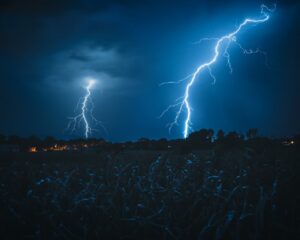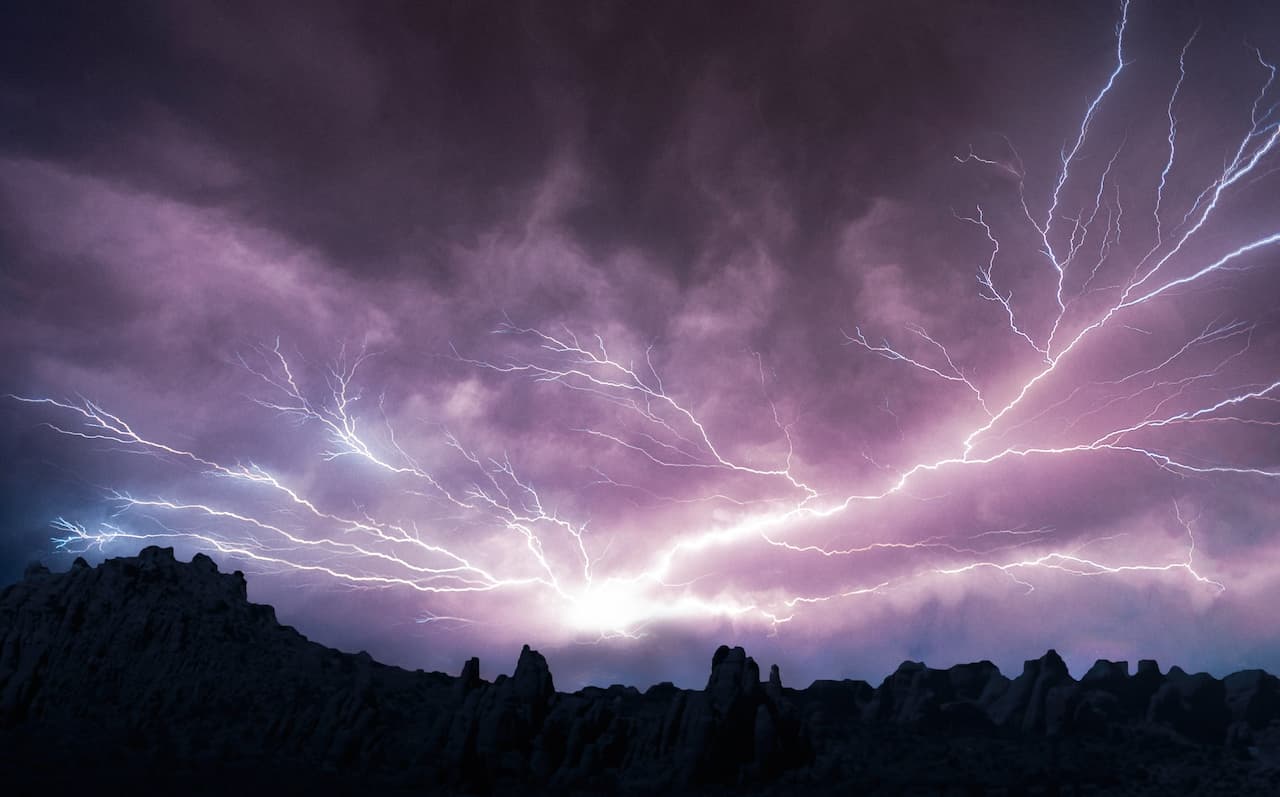How Does Lightning Work?
As long as there have been humans, lightning has fascinated and frightened mankind. This natural event occurs when a big cumulonimbus cloud (thunderhead) collides with an updraft, releasing its stored energy.
An electrical field develops around a cloud, with negative charges near the ground and positive ones at the cloud’s peak. A breaking point is reached when the charges can no longer be controlled due to their accumulation. This triggers the emission of a massive flash of electricity (lightning) that may reach up to 100 million volts.
cloud’s peak. A breaking point is reached when the charges can no longer be controlled due to their accumulation. This triggers the emission of a massive flash of electricity (lightning) that may reach up to 100 million volts.
The air immediately around such a discharge may be vaporized, resulting in the signature thunderclap, due to the extreme heat generated. Although we have learned a lot about lightning, we are still in awe of its incredible force.
In this blog post, we’ll take a look at some of the theories about how lightning forms, and what happens when it strikes.
What is Lightning?
Lightning is a giant spark of electricity in the atmosphere. It occurs when the air around a thunderstorm becomes so charged with electricity that it begins to jump from one point to another.
Charges in Clouds Theory
One theory about how this happens is called the Charges in Clouds theory. This theory says that as clouds move, they rub against each other and create an electrical charge. This charge builds up until it is released in a giant spark of lightning.
Static Electricity Theory
Another theory is called the Static Electricity theory. This theory says that as air rises and falls within a thunderstorm, it creates an electrical charge. This charge builds up until it is released in a giant spark of lightning.
How does lightning actually form?
Lightning is one of nature’s most impressive displays. It is also one of the most dangerous, capable of causing devastating fires and inflicting serious injuries. But how does it actually form?
devastating fires and inflicting serious injuries. But how does it actually form?
Contrary to popular belief, lightning does not require storm clouds. It can occur during any type of thunderstorm, as long as there is rising air and an area of low pressure. As the air rises, it cools and condenses into water droplets. These droplets eventually form clouds, which are then struck by a discharge of static electricity.
The resulting flash of light is what we know as lightning. While the process is relatively simple, the consequences can be anything but. Lightning is responsible for thousands of deaths and injuries every year, making it one of the most dangerous weather phenomena in the world.
Lightning is one of the most powerful forces on Earth, and it is still not fully understood. Scientists are still working to figure out how it works, and what happens when it strikes.
Types of Lightning
There are two types of lightning: cloud-to-ground and cloud-to-cloud.
Cloud-to-Ground Lightning
Cloud-to-ground lightning is one of the most dangerous types of weather conditions that a person can encounter. While it is amazing to watch from a distance, being close to cloud-to-ground lightning is extremely dangerous and can often lead to death.
The main reason why cloud-to-ground lightning is so dangerous is that it is incredibly powerful.
A single bolt of cloud-to-ground lightning can contain up to one billion volts of electricity. This high voltage combined with the fact that cloud-to-ground lightning often strikes without warning makes it a very deadly weather phenomenon.
If you are ever caught in a thunderstorm, it is best to seek shelter immediately and avoid being outside in open areas.
Cloud-to-Cloud Lightning
Cloud-to-cloud lightning is a type of lightning that occurs between two or more clouds. It is the most common type of lightning, accounting for about 75% of all flashes.
Unlike cloud-to-ground lightning, which typically only lasts for a few milliseconds, cloud-to-cloud lightning can last for several seconds or even minutes. During this time, the area between the clouds becomes illuminated with a bright light. In some cases, lightning can be seen from the ground.
However, it is more often than not visible only to pilots or other people who are high up in the sky. While cloud-to-cloud lightning is not as dangerous as cloud-to-ground lightning, it can still pose a threat to aircraft and other high-altitude objects.
As a result, pilots and other individuals who work in high places should be aware of the dangers of cloud-to-cloud lightning and take precautions to avoid it.
Does lightning go up or down?
Does it always travel from the ground up? The answer, surprisingly, is no. In fact, lightning can travel either up or down, depending on the conditions. If there is a taller object nearby, lightning will often strike it first.
However, if there are no taller objects, lightning will strike the ground first and then travel upward. So the next time you see a thunderstorm rolling in, keep an eye out for a flash of lightning – you never know which way it will go.
The Impact of a Lightning Strike
A lightning strike is one of the most powerful natural forces on Earth. In an instant, a bolt of electricity can heat the air to temperatures five times hotter than the surface of the sun, creating a shock wave that can travel at speeds of up to 100,000 miles per hour.
This incredible force can cause serious damage to property and even lead to death! Fortunately, lightning strikes are relatively rare, but when they do occur, the consequences can be severe. In addition to causing fires and electrical damage, a lightning strike can also cause brain injuries, heart damage, and burns.
As a result, it is important to take precautions to avoid being struck by lightning. If you are caught in a thunderstorm, stay indoors and avoid touching metal objects. If you are outdoors, try to find shelter in a building or car.
And if you are caught in an open field, crouch down low to the ground and minimize your contact with the ground. By taking these precautions, you can help to protect yourself from the potentially devastating impact of a lightning strike.
Consequences of Lightning
A thunderstorm is a type of storm that is characterized by the presence of lightning and thunder. Thunderstorms are relatively common in many parts of the world and can occur at any time of year. There are several factors that can contribute to the formation of a thunderstorm.
One of the most important is the presence of moist air. When warm, moist air rises into the atmosphere, it can create instability in the atmosphere and lead to the development of thunderstorms.
Other factors that can contribute to the formation of thunderstorms include changes in air pressure, fronts, and topography. In some cases, thunderstorms can also be triggered by man-made activities, such as the use of explosives.
Conclusion
It is still not completely clear how lightning works, but scientists believe that it has to do with the way that charges build up in the atmosphere. When these charges get too strong, they are released in a giant spark of electricity.
When lightning strikes, it may destroy buildings and even take lives. Lightning strikes are uncommon, but when they do happen, people need to take safety measures to prevent getting hit. Be safe and remain indoors during a storm, and don’t touch anything metal.
Get inside a structure or a vehicle if you can’t avoid being outside. If you are cornered in an open area, squat low to the ground and try to make as little touch with the ground as possible.





